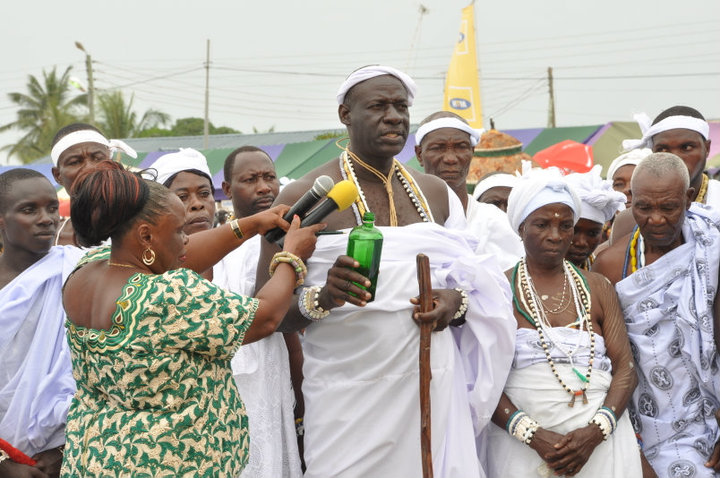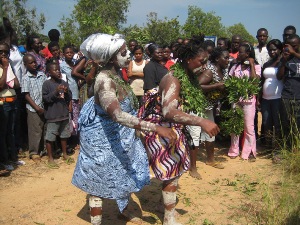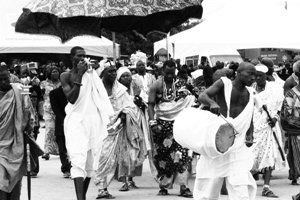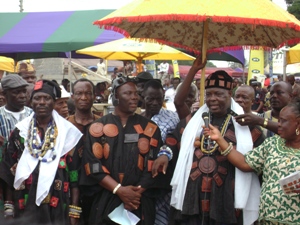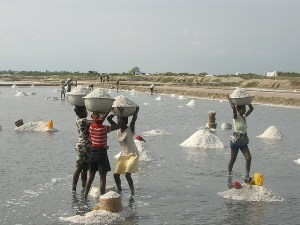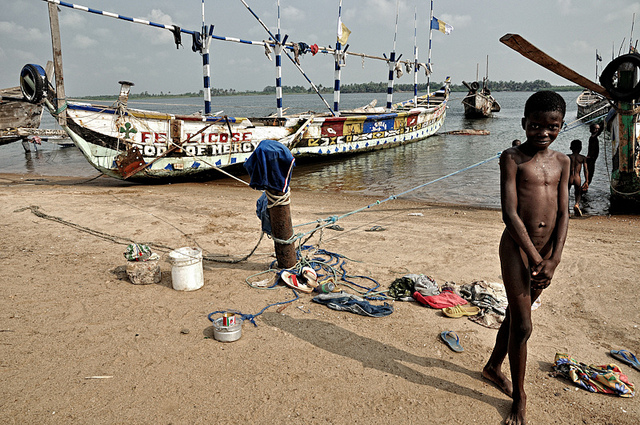REVIEW- HISTORY, CULTURE & TRADITIONS- Re: TRIP DOWN MEMORY LANE- ADA PEOPLE [OF GHANA]: THE TRADITIONALIST DANGME PEOPLE AND THEIR UNIQUE ASAFOTUFIAMI FESTIVAL
PEOPLE & PLACES
In the words of the Ghana Districts [1]; “the Ada people are fishery and agricultural Dangme-speaking people that forms a subset of the larger Ga-Dangme ethno-linguistic group living in the southern Ghana.” But historically, the composition of Ada ethnicity might go beyond Ga-Adngbe culture and traditions. According to the report, the Ada people were made up of the four original Dangme clans: the Adibiawe, Lomobiawe, Dangmebiawe, and Tekperbiawe. “These clans, the Okorli, integrated one Akan clan- the Kabiawe and incorporated three Ewe clans: the Kudragbe, Korgbor and Ohuewem. The Ada later on adopted 9 additional Ewe villages, Agave, Sukpe, Tefle, Vume, Blakpa, Mlefi, Mepe, Battor, and Duffor, to form the Ada Nation. Ada-Foah is the district capital of Ada people. Some of the other notable towns are Kasseh, Akplabanya, Sege Junction, Anyamam, Pute, Lolonya, Tamatoku, Bonikope, Songor, Adzomanukope, Bedeku, Wokume Gbe, Songutsokpa, Big-Ada, Got, Koluedor ,Totimekope, Ocanse Kope, Totope, Kasseh, Matsekope.” So; as the peoples of Ada begin their annual festival- Asafotufiame in August, both the familiar and the foreign will be witnessing not only the culture and traditions rooted in Ga-Adangbe but also, the beauty in diversity- showcasing colourful historical clues as to how Ada/Oda, got its current name.
INTRODUCTION
Geographically, Ada lies in the Dangme East District, off the Eastern part of Greater Accra Region and within Latitudes 5°45 South and 6°00 North and from Longitude 0°20 West to 0°35 East. It shares common boundaries with North Tongu District to the North, South Tongu District and Dangme West Districts to the East and West respectively. To the south is the Gulf of Guinea, which stretches over 45 kilometers (27.9 miles) from Kewunor to Wokumagbe. The territory covers a total land area of 909 sq km (350 sq miles) and represents about 28% of the total land size of the Greater Accra Region. Being a coastal district, most people along the coast have taken to fishing and fish processing as their main source of livelihood. Also, the sea has a cooling effect on the people especially during hot seasons but the corrosive nature of the breeze is very destructive [1].
HISTORY & TRADITIONS
The historian Reindorf reports a tradition that after repeated removals of this tribe from place to place in consequence of incessant invasions, they said to one another: ‘Wadahe’- meaning, “we have been scattered miserably about”. But it is argued that in tracing the roots of Ada, the one given by one King Frempong Manso, of Akyem Kotoku, after the name of his capital- Da or Oda, is the most comprehensible. Historian J. K. Fynn writes that following the Akyem’s defeat of Akwamu, Frempong Manso and Ba Kwante of Abuakwa shared authority over Accra and the Adangbe area. Owusu Akyem, son of a sister of the Okyenhene, became the administrator of the Adangbe area. [2]
“The Akyem conquest of Akwamu in 1730 was one of the most decisive victories in Gold Coast history. The event was described by contemporaries as the greatest revolutions that had taken place in that part of the world since the Akwamu themselves destroyed the old Ga Kingdom in the late seventeenth century.” [ibid] With this, it might be persuasive to conclude that contemporary Ada and its traditional capital- Ada Foah; are the brainchild of King Frempong Manso, whose ancestors, are said to be the architects of the foundation of most Asante-Akyem towns- such as as: Bomfa, Agogo-Hwediem and Dampon, all in the Asante kingdom. Like Akyem Abuakwa and Akyem Bosome, Kotoku, deemed to have been existence since 1500 A.D, traces its roots to Adanse and as one of the military wings of Denkyira Empire, which the emerging Asante, defeated in the 1700s[3].
But in his article: “Trip Down Memory Lane- Ada People: The Traditionalist Dangbe People and their Unique Asafotufiami Festival”, E.A. Kabutey attributes an explanation to C.M.K.Mamattah, also given by Ghana Districts, as follows: “it was at Notsie, where the proto-Ga-Dangme had joined the Ewe, that “King Agorkoli appellated the Adas as ‘Adawolawo’- meaning, a wild, furious, brave and warlike people who are easily provoked”. Kabutey also describes a tradition which assigns the name to a later period, after the people had crossed the Volta and were attempting to settle further south. According to this account, the Okorli- which was the name by which they were called at the time, were repeatedly attacked by the Akwamu, but eventually defeated them at Akplaba [4].
“A truce was then negotiated, in which the Okorli unwisely “cut off one arm of their leader Chayi” which they submitted to the Akwamus to show their commitment to ending the numerous wars. Understandably, Chayi is reported to have been unappreciative of this gesture, saying, “curse be unto you, wicked and ungrateful people! With this very arm have I won several victories for you! You shall be cursed forever”. In the words of Kabutey, it was this last phrase, which comes from the Dangme “nye ma da” which was then shortened to ‘Ada’. “The Coastal Ada people speak a Dangme language of Kwa language group which belongs to the larger Niger-Congo phylum.” [ibid]
The Asafotufiame Festival
The diversity of the people, culture and traditions of Ada people might probably be puzzled or comprehended not only from the evolution of the name Ada but also, from the annual Asafotufiame festival celebrated around the first week of August, in remembrance of the achievements in the war for settlements fought by the ancestors of Ada. “ASAFOTUFIAMI” as the name implies, is company firing of musketry. In the olden days, the Ada state was made up of the following states with their Divisional Chiefs supporting the Ada Mantse as the Paramount Chief and the various Clans at Big-Ada: “Agave, Sokpoe, Tefle, Mepe, Mafi, Bakpa, Battor” with the secession of these Divisional Chiefs to form what is now known as the Tongu State, the new post of Wetsoyi (Divisional Chiefs), has been created in addition to the following State Clans of Ada, which formerly, were under their respective Wornorhi and Asafoatseme.” That’s the history of the festival. [1]
Little is known about when this Akan-Adangbe-Ewe derived festival- ASAFOTU-FIAMI was first celebrated. But Ghana Districts[ibid] adds that since 1954, the following ten (10) clans: Adibiawe; Ohuewem ; Kabiawetsu; Lomobiawe; Korgbor; Kabiaweyumu; Terkpebiawe; Kudzragbe; Kpono; and Dangmebiawe, have had Wetsoyihi (Divisional Chiefs) to support the paramount stool of Ada.” The greater Dangme group comprised of the Ada, and others known today as the Krobos, Osudokus, Shais, Kpones, Prampram and Ningos. “From “Seme” they came to Oyo and then to Abeokuta, then to Dahomey, now Benin. In Dahomey, the Adas were forced by hostilities in that land from establishing an exclusive settle, so they merged with the Ewes from Ketu. Then with the Ewes they traveled to a place called Tado and accompanied them again up to Ngotsie in Togo.”[ibid]
It is said that the part of the Adas that were among this great migration were the four (4) Okor Clan led by a priest King known as Adi. They are Adibiawe, Lomobiawe, Tekperbiawe and Dangmebiawe, who together with Krobos, Osudokus and the Shais, travelled by the overland route and crossed the Volta River at several points such as Aprade, Fodjoku near Akuse, Dorfor, Asutsuare and Vume. “The four (4) Okor tribes have a common taboo. The priests established a theocratic political institution which forbade them from seeing human blood. However, to sanctify the priesthood they must be circumcised. The crossing of the river at Asutsure was said to have come about as a result of a mystic, Tsa Avegbe, who is said to have jumped into the Volta River and emerged as a crocodile, with as wide as an Odum board and spread across the Volta River for the crossing. [ibid] It is of interest to note that in all these; nowhere, was Asafotufiame, mentioned.
Thus, the Adas and in general, the Adangbes, were still on the move with Adi and followers, being the first to sail, followed by Lomo and Lomobiawe who came second and thereafter, Terkperbiawe. Led by Okumo, Dangmebiawe, is said to have crossed last as the gate sealers. “After crossing, all the Dangme tribes settled at Togologo now called Lolorvor which is now known as Accra plains, for many years…It was said that, there arose a misunderstanding between them and the Manya leaders. The other members of the group tried to persuade Adi to bury the difference but the Adas told the Krobos in the Ewe language that “Lolorvor”, which means the cord binding us together, is broken or severed; there is no more love to unite us. This saw the Krobos heading to the Shai hills, leaving the Adas (Okor Clan) behind on the Accra Plains at Lolorvor near the present day Afienya hills.” [1] There is a cliché in Ghana states that when an Ada grows older, s/he can eventually become an Ewe.
Yes, there could be many historical heights that warrant the celebration of Asafotufiame which probably epitomises two combined words derived from Akan and Ewe Languages- “Asafotu and fiame”. Kabutey [2] reminds us of the following ancient wars which links the oaths of allegiance sworn by the Asafoatseme to the Paramount Chief. “In the Ada-Anlo War- battle of Nonobi, Adas supported by Akwapim, Akim Abuakwa, Krobo and Agave defeated Anlo. In the unsuccessful invasion of Anlo by Ada, Akim Abuakwa, Akwapim, Krobo and part of Mefi, Akwamu supported Anlo, Ada was attacked by Anlo and its Township burnt down. Ada was prominent in Kantamanso War near Dodowa against the Asantes which Sir Charles McCarthy died and the Asantes defeated. War Capt. Glover invaded Anlo with forces drawn from Ga, Ada, Krobo, Krepi Akwapim, while Anlo, supported by Avonos and Mafi, were defeated at battles near Adidome, Aveno and Wheta.”
History has it that the Akan war raids especially that of the Asante, forced the search for place of safety of the ancient Ada peoples. “A survey team of famed hunters drawn from the four (4) clans set from “Lolorvor” to explore new lands for settlements… Their exploration took them as far as to the Sege forest and the stream. At this place, Korley climbed a tree and surveyed all the land beyond and beheld a white sheet of land in the distance and all the four (4) famed hunters moved out to see what it was. Adi took the lead followed by Lomo, Korley with Okomo at the rear… This brought about the discovery of Songor Salt Lagoon. Adi and Lomo went by the North of the lagoon and came as far as Togbloku. Korley and Okumo also took to the south and came across the Okor forest by the sea where they walked up to the Volta estuary, near the present day Lolonyakope.”[1]
It was alleged that one day, Korley went out on a hunting expedition and reached as far as Wokumagbe near Ningo. There he shot at and wounded a beast but it ran away. Korley decided to follow the foot print of the beast until he reached a thick forest. In pursuit of the beast into the forest, he discovered a secret hamlet and met an old lady seated on a stool, adored with gold. “Around her, Korley saw crowd human beings which to him, were apparitions and turned to retrace his steps to give up the pursuit of the wounded beast. She then asked Korley where he came from and he pointed out the direction of Afienya hills at Lolorvor….She told Korley that if he could faithfully observe the taboos and the preclusion on the usage of the lagoon, and be faithful to his oath of fidelity to her, she will turn over the ownership of the Songor Lagoon to him.” The historical myth is that the old lady asked Korley to assure her that when she gives up the ownership of the Songor Lagoon, neither he nor his, children after him, shall ever use GOLD as an Ornament.
But had the people of Ada been able to UPhold the ancient taboo of the old lady- “never ever to use GOLD as an Ornament? It is said that the Songor lagoon has a fetish priest- presumably, contemporary representative of the ancient goddess- called Libi Womor, who is responsible for maintaining traditional beliefs and practicing the required rituals for the main sacred shrine called ’’yomo’’. “Libations and other rituals are performed every year and these already attract domestic and some international tourists including those who want to learn more about traditional beliefs surrounding the songor lagoon. Shrines such as Dasuma and Dada piem are also found in Big Ada.”
The Adatourism[5] notes that only few people know where Ada Foah [corrupted Ada Fort] has got its name from- the reason is the fort near the Presbyterian Church that gave the town its name to distinguish the two Adas: Ada Fort, from the village of the fort. The small Fort Kongenstein- built by the Danish in 1783 and was purchased by the English on the 15th of March 1850 has, according to Dr Isaac Ephson[6], since disappeared into the sea and only traces of it could be seen. The ancient “Asafotu” Festival which, thanks to sons and daughters of Ada, rebirth in 1937 after some breaks, can boast of two (2) Asafo (companies): Akomfode and Asorkor, within the Ada State. It is of interest to note that traditionally, membership to these groups is by matrilineal linage. For this reasons, Kabutey[4] informs that children of the same father and different mothers at times find themselves in the opposite “Asafo company” and this confirms the appellation of the people of Ada as “Nyeko Bi, Tseko Bi”. According to tradition, the celebration starts from Thursday in the 1st week of August with the arrival of natives, well wishers and guest(s) from other places to the town.
“The Thursday is devoted for house cleaning ceremony and pouring of libation at the respective shrines of the various families and keeping of vigil. At dawn on Friday, as part of the schedule for the celebration, the two companies (Asafo) beat their respective drums to summon their members for the onward march to LUHUESE on the outskirts of Big-Ada where they are compelled and according to ancient custom, all young men who attain the puberty age were then initiated into their respective Asafo companies by taught how to handle, load a gun and fire same for the first time. This is followed by war formation and ancient tactics of warfare [drills until sunset] when they will return to the Big-Ada dressed in traditional military attire and clad with leaves and palm branches signifying conquering heroes returning from the war fronts amid firing of musketry and war cries- and the traditional rituals with its linguistic tones such as: Awoo Awooo!!- Response: Awe-e-e-e – Agba e, Bleku Tso – Nsu, O, Nsu – Enam O, Enam Manye O, Manye – Adubani Kpotoo,” observed.
Although Kabutey fails to explain such words like: Awoo! Awe-e-e-e-e; Agba e, Bleku Tso, with the understanding of Nsu, O, Nsu[water], Enam[meat/fish] and Adubani Kpotoo [abudance of food], one is tempted to conclude this with the various fireworks, jubilations, fun-funfairs and merriments associated with almost all the traditional festivals in Ghana. In Ada, as in most traditional areas, the following Saturday is noted for durbar of the Paramount Chief, Divisional Chiefs and Asafoatseme carried in their palanquins through the town to the Big-Ada Presbyterian Junior Secondary School Park where people from all-walks of life congregate to receive them. On the Saturday and Sunday, Ada Youth Groups and other benevolent Societies established in certain towns of the country also parade through the street of Big Ada to the durbar grounds in their unique uniforms, where they march past with their patriotic and melodious songs to grace the occasion. [4]
After the Paramount Chief had greeted the Divisional Chiefs, Asafoatseme and Eiders and the People, he sits -in state to receive in return, Greetings and homage of his people and swearing of Allegiance by the Asafoatseme at which each swearing is sealed with volleys of musketry by the divisions. The Military Organization of Ada is listed as follows: Adibiawe (Hlam T); Korgbor (Dzase-Hem); Lomobiawe (Hlam Ta); Kudzragbe Dzase se (Atufo); Tekpebiawe (Hlam Ta) ; Kabiawetsu; Dangmebiawe (Se Ta); Kabiaweyumu; Ohuewem (Kpeti Ta) and KabiaweKpono. The following Sunday is dedicate for a non-denominational open air Church Service which is held at the same venue of the Durbar “to give praise and thanks to the Almighty God for his abundant blessing for the success of the festival and from the following week day- Monday to Thursday, set aside for Boat Racing, Tug of War, Get-together for the aged, River excursion, Football matches and greeting of individuals and bidding good bye to each other with happy memories of the year.”
In the words of Kabutey, the Dangme have many inspiring proverbs and the ones relevant which according to Kabutey, provide hope in times of scepticism and despair, or when people are tempted to ask, ‘Can anything good come out o’ Nazareth,’ are cited here. Kabutey states also that one may also rely on them when faced with anxiety about a new situation: “Bë momo bëö pe bë he- an old broom sweeps better than a new broom- not only does this particular proverb extols the old broom; [it compares it with the new, grades the old one higher and even discourages the use of the new broom.]. A woö ma bi ta në ke a ya wo ö a gbeö yayi- one may expect tiny herrings and yet go fishing and catch mackerel or kingfish.” Ada might not been blessed with silver and gold but globally, it can boast of Songhor Lagoon, salt development, fishing and agricultural activities, livestock pursuits and poultry, not forgetting outstanding beaches and beautiful riverfront scenery.
The port of Ada, located at the mouth of the Volta River provides friends and families with a Jet Ski safari-like resort. But the unfamiliar holiday-makers must be careful. Here is where the Musician Castro- known in private life as Theophilus Tagoe, had been reporter feared missing, along with his friend- Janet Bandu, on 6 July 2014, following a Jet Ski accident in the Volta Estuary. The sandy beach within the songor lagoon is worth visiting. It is found that every year during the nesting season- August and February; three species of female marine turtles come to the beach to lay their eggs in holes dug with their flippers and drop between 80-150 eggs in it at a time in a unique way. It takes between 6-8 weeks for the egg to hatch and the hatchings proceed to the sea almost instantly.
In effect, the beginning of August offers a great opportunity for all [but with the caveat of sporadic downpours- courtesy, Ghana Metrological Authority] to witness Ada, its culture and tradition which are arguably, the true presentation of Ghana. JusticeGhana wishes Ada 2015- “Awoo Awooo- Awe-e-e-e – Agba e, Bleku Tso – Nsu, O, Nsu – Enam O, Enam Manye O, Manye – Adubani Kpotoo,..”
This article was researched and compiled by The OmnabaPa Research Group
JusticeGhana
……………..
References
[1] Dangme East District Assembly (2006) “Background of OF Asafotufiame Festival”, http://dangmeeast.ghanadistricts.gov.gh/?arrow=atd&_=7&sa=6110, date accessed, 31 July 2014[2] J. K. Fynn, “Asante and Akyrm Relations 1700 — 1831, http://archive.lib.msu.edu/DMC/African%20Journals/pdfs/Institue%20of%20African%20Studies%20Research%20Review/1973v9n1/asrv009001004.pdf
[3] Akim Kotoku Association UK(July2014), “History: Akim Kotoku”, http://www.akimkotoku.co.uk/index.php/about/
[4] E.A.Kabutey (17 September 2013) “Trip Down Memory Lane- Ada People: The Traditionalis Dangbe Peole and their Unique Asafotufiami Festival”, http://kwekudee-tripdownmemorylane.blogspot.com/2013/09/ada-people-traditionalist-dangme-people.html
[5] http://adatourism.wordpress.com/things-to-see/sights/fort-2/
[6] Ephson, Isaac S., “Ancient Forts and Castles of the Gold Coast (Ghana), Ilen Publications, Accra 1970, page 83, cited from http://www.ghanamuseums.org/forts/fort-kongenstein.php, date accessed, 31 July 2015

